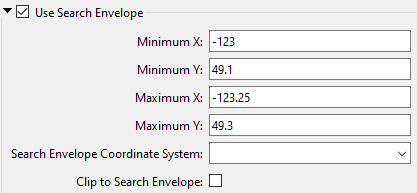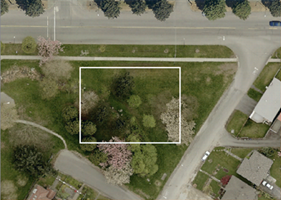Reader Configuration
Specifies whether to read the XML dataset using Feature Paths, an xfMap document, or an XRS document.
Sets a limit for the number of data features scanned for determining schema features.
This option is useful during workspace generation when processing a very large XML file, and you know that the entire file does not have to be read to completely determine the feature type definitions.
Valid values: any positive number
Feature Paths Configuration
Specifies which XML elements in the dataset, expressed as xfMap match expressions, should be extracted into features containing XML fragments. Multiple expressions can be separated with whitespace. The fragments are held in non-geometrical FME features under their xml_fragment attribute.
Three additional attributes are added to the feature. One records the element that was matched (the xml_matched_element attribute); the other holds an ID for that element (the xml_id attribute); and the last one holds an ID for the parent ID of that element (the xml_parent_id attribute).
- The
xml_matched_elementmay be used to identify which element matched the expression in the case that the last component of the matched expression is a wildcard, “*”. Note the value for thexml_matched_elementis also set as the feature type for the features. - The
xml_idattribute is not globally unique. The xml_id must be unique for the entire dataset. FME will use the xml_id to make the associations between the XML objects. If you already have an id in your data (my_id), you can use a prefix to make it unique. For example: customer-@Value(my_id). - The
xml_parent_idattribute is empty if the parent of the element is not matched or it does not have any parent. -
The
xml_parent_child_poscontains the position of the element in relation to its parent. If the parent of the element is not matched or it doesn’t have any parent, then this attribute is empty.
This parameter is useful for deconstructing large XML documents into parts that may be processed further in XML, XQuery, XSLT or text processing FME Workbench transformers.
This example extracts the children of the <dc:SearchResults> element from the dataset into XML fragment features:
XML_XFMAP_FEATURE_PATHS “csw:SearchResults/*”
Specifies which XML elements in the dataset, expressed as xfMap match expressions, should be excluded from extraction into features. This parameter is especially useful for match expressions containing wildcard characters. Multiple expressions can be separated with whitespace.
This example excludes extraction of the <csw: metadata> children of the <dc:SearchResults> element from the dataset into XML fragment features:
XML_XFMAP_FEATURE_PATHS_EXCEPT "csw:SearchResults/csw:metadata"
Customize Attributes
This parameter can be specified to extract the children of the matched elements as xml fragments.
For example, If Flatten Options is shipto and this parameter is set to country, then the output feature has an extra attribute xml_fragment_country{0} with its value set to <country>Norway</country>.
Flatten options allow children of the matched elements to be exposed as attributes on FME Features.
Exclude XML Fragment Attribute – Specify whether to exclude the xml_fragment attribute when flattening. By default, this is unchecked, therefore the xml_fragment attribute is produced.
Other Configurations
If the Configuration Type parameter is xfMap, this parameter identifies the location of the xfMap document. Multiple xfMap files may be specified here.
If the Configuration Type parameter is XRS, this parameter identifies the location of an XRS document. An XRS (XML Reader Switch) document allows the XML Reader to automatically configure itself to read "known" XML datasets without the need to specify the appropriate xfMaps in advance.
If there is no Feature Path or xfMap provided, FME makes a best guess and uses xfMaps it finds internally to try to parse it. However, the results will be unpredictable and the xfMap that FME is attempting to use, if any, will be written in the log. In this case, the XML reader is using the AIXM xfMap to try to read the source data:
INFORM|The XML Reader is using xfMap 'C:\Apps\FME\xml\aixm\aixm_4_5_xfmap.xml'
Continue on Geometry Error
Specifies whether the reader should continue to extract features from the XML dataset after encountering a geometrical error.
General
Specifies whether the input xfMap document should be validated against its Document Type Definition (DTD).
Specifies whether the input XML document should be validated against a DTD or an XML schema.
Setting this parameter to Yes instructs the underlying XML parser to disable the loading of an external DTD.
This parameter controls whether external entities can be substituted.
- Enabled (default) – A custom entity resolver is used to resolve external entities such as DTDs. The installed custom entity resolver relies on a URI Map that maps incoming URIs to resolved URIs. (The resolved URIs are usually URLs with local copies of the resource.)
- Disabled – If an XML document does not have any external entities that need to be resolved, the Entity Resolver can be set to Disabled. When this parameter is disabled, the URI Map will not be loaded unnecessarily.
Schema Attributes
Use this parameter to expose Format Attributes in FME Workbench when you create a workspace:
- In a dynamic scenario, it means these attributes can be passed to the output dataset at runtime.
- In a non-dynamic scenario, this parameter allows you to expose additional attributes on multiple feature types. Click the browse button to view the available format attributes (which are different for each format) for the reader.
Spatial
Coordinate systems may be extracted from input feature data sources, may come predefined with FME, or may be user-defined. FME allows different output and input coordinate systems, and performs the required coordinate conversions when necessary.
If a coordinate system is specified in both the source format and the workspace, the coordinate system in the workspace is used. The coordinate system specified in the source format is not used, and a warning is logged. If a source coordinate system is not specified in the workspace and the format or system does not store coordinate system information, then the coordinate system is not set for the features that are read.
If a destination coordinate system is set and the feature has been tagged with a coordinate system, then a coordinate system conversion is performed to put the feature into the destination system. This happens right before the feature enters into the writer.
If the destination coordinate system was not set, then the features are written out in their original coordinate system.
If a destination coordinate system is set, but the source coordinate system was not specified in the workspace or stored in the source format, then no conversion is performed. The features are simply tagged with the output system name before being written to the output dataset.
For systems that know their coordinate system, the Coordinate System field will display Read from Source and FME will read the coordinate system from the source dataset. For most other input sources, the field will display Unknown (which simply means that FME will use default values). In most cases, the default value is all you'll need to perform the translation.
You can always choose to override the defaults and choose a new coordinate system. Select More Coordinate Systems from the drop-down menu to open the Coordinate System Gallery.
Changing a Reprojection
To perform a reprojection, FME typically uses the CS-MAP reprojection engine, which includes definitions for thousands of coordinate systems, with a large variety of projections, datums, ellipsoids, and units. However, GIS applications have slightly different algorithms for reprojecting data between different coordinate systems. To ensure that the data FME writes matches exactly to your existing data, you can use the reprojection engine from a different application.
To change the reprojection engine, Select Workspace Parameters > Spatial > Reprojection Engine. In the example shown, you can select Esri (but the selection here depends on your installed applications):
- The coordinate systems file coordsys.db in the FME installation folder contains the names and descriptions of all predefined coordinate systems.
- Some users may wish to use coordinate systems that do not ship with FME, and in those cases, FME also supports custom coordinate systems.
- Learn more about Working with Coordinate Systems in FME.
A search envelope (also known as a bounding box) is a rectangular area that defines a geographic area. In FME, the easiest way to define a search envelope is to use search envelope parameters.
Defining a search envelope is the most efficient method of selecting an area of interest because FME will read only the data that is necessary – it does not have to read an entire dataset. Search Envelope parameters apply to both vector and raster datasets and can be particularly efficient if the source format has a spatial index.
Most FME readers have parameters to define the search envelope of data that is being read:

The parameters include the x and y coordinates of the bounding box as well as a parameter that defines the coordinate system.
How to Define the Bounding Box
Using the minimum and maximum x and y parameters, define a bounding box that will be used to filter the input features. Only features that intersect with the bounding box are returned. Note that the bounding box intersection is not a full geometry intersection (based on spatial relationships) that would be returned by a transformer like the SpatialFilter.
|
Search Envelope Coordinate System |
Specifies the coordinate system of the search envelope if it is different than the coordinate system of the data. The coordinate system associated with the data to be read must always be set if this parameter is set. If this parameter is set, the minimum and maximum points of the search envelope are reprojected from the Search Envelope Coordinate System to the reader’s coordinate system prior to applying the envelope. |
||||||
|
Clip to Search Envelope |
The underlying function for Use Search Envelope is an intersection; however, when Clip to Search Envelope is checked, a clipping operation is also performed.
|




